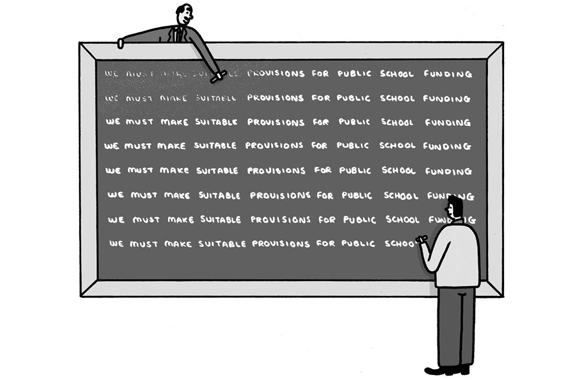Illustration By David Biskup. New York Times
Once upon a time every state in the Union, unequivocally guaranteed a free public education in its Constitution, but that soon may end. Within the month we will know more. The Kansas Supreme Court is expected to decide what Governors and Legislators could choose to override. As soon as a decision is rendered Kansas Governor Brownback will reveal his plan. At present, he and possibly as many as forty-five Governors or as few
What’s the Matter With Kansas’ Schools?
KANSAS, like every state, explicitly guarantees a free public education in its Constitution, affirming America’s founding belief that only an educated citizenry can preserve democracy and safeguard individual liberty and freedom.
And yet in recent years Kansas has become the epicenter of a new battle over the states’ obligation to adequately fund public education. Even though the state Constitution requires that it make “suitable provision” for financing public education, Gov. Sam Brownback and the Republican-led Legislature have made draconian cuts in school spending, leading to a lawsuit that now sits before the state Supreme Court.
The outcome of that decision could resonate nationwide. Forty-five states have had lawsuits challenging the failure of governors and legislators to provide essential resources for a constitutional education. Litigation is pending against 11 states that allegedly provide inadequate and unfair school funding, including New York, Florida, Texas and California.
Many of these lawsuits successfully forced elected officials to increase school funding overall and to deliver more resources to poor students and those with special needs. If the Kansas Supreme Court rules otherwise, students in those states may begin to see the tide of education cuts return.
Kansas’ current constitutional crisis has its genesis in a series of cuts to school funding that began in 2009. The cuts were accelerated by a $1.1 billion tax break, which benefited mostly upper-income Kansans, proposed by Governor Brownback and enacted in 2012.
Overall, the Legislature slashed public education funding to 16.5 percent below the 2008 level, triggering significant program reductions in schools across the state. Class sizes have increased, teachers and staff members have been laid off, and essential services for at-risk students were eliminated, even as the state implemented higher academic standards for college and career readiness.
Parents filed a lawsuit in the Kansas courts to challenge the cuts. In Gannon v. State of Kansas, a three-judge trial court ruled in January 2013 for the parents, finding that the cuts reduced per-pupil expenditures far below a level “suitable” to educate all children under Kansas’ standards.
The judges also found that the Legislature was not meeting even the basic funding amounts set in its own education cost studies. The judges called the school funding cut “destructive of our children’s future.”
To remedy the funding shortfall, the judges ordered that per-pupil expenditures be increased to $4,492 from $3,838, the level previously established as suitable.
Rather than comply, Governor Brownback appealed to the Kansas Supreme Court. A decision is expected this month.
A victory for the parents would be heartening, but if it comes, would Governor Brownback and legislative leaders uphold the right to education guaranteed to Kansas school children?
The signals thus far are not promising. If the Kansas Supreme Court orders restoration of the funding, legislators are threatening to amend the state’s Constitution by removing the requirement for “suitable” school funding and to strip Kansas courts of jurisdiction to hear school finance cases altogether. And if the amendment fails, they have vowed to defy any court order for increased funding or, at the very least, take the money from higher education.
A court-stripping constitutional amendment, and defiance of a state Supreme Court order, would shred the very fabric of Kansas’ government and send shock waves through state capitals across the nation. It would allow elected branches to avoid any responsibility to adhere to the language and interpretation of their state constitutions by the courts. It would gravely undermine judicial independence and shut the courthouse door to vulnerable children who, as a last resort, seek legal redress to vindicate their fundamental right to an education.
As the Gannon trial judges noted, matters such as education are placed in constitutions because they are “intended for permanence” and “to protect them from the vagaries of politics.”
Kansans rightfully take pride in their strong public school system. But as Kansas goes, so may go the nation. The Kansas Constitution, like those in other states, demands that every child be given the educational opportunity to meet his or her promise. This requires, at a minimum, adequate and suitable school funding. Governor Brownback and legislators must meet the constitutional command and, by so doing, advance the core American value of equal opportunity for all.
David Sciarra is the executive director of the Education Law Center. Wade Henderson is the president and chief executive of the Leadership Conference on Civil and Human Rights.












Leave A Comment